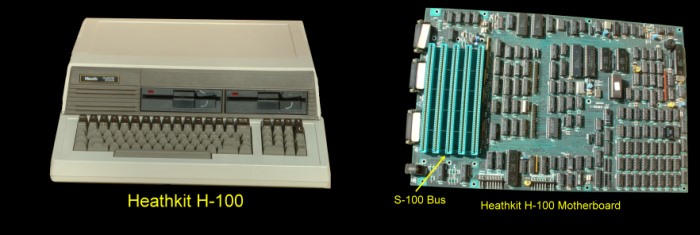The history of Heathkit goes back many decades to a time when electronic
computers of any kind was unheard of.
The company was originally founded as an aircraft company in the early 1900s
by Edward Bayard Heath and was called
The Heath Company. Starting
in 1926 it sold a light aircraft, the Heath Parasol, in kit form. Heath died
during a 1931 test flight. In 1935, a guy named Howard Anthony purchased the
then-bankrupt Heath Company, and focused on selling accessories for small
aircraft. After World War II, he decided to enter the electronics industry
and bought a large stock of surplus wartime electronic parts for a hobbyist
electronic kit business. In 1947, Heath introduced his first electronic kit,
an oscilloscope and sold it for $50. It was an immediate hit and
launched the company.
Over the decades Heathkit -- as it was called -- went on to sell all kinds
of electronic kits, amplifiers, radios etc. Often with great success.
Howard Anthony died in 1954 and the company went through a few transitions
to become part of a large consortium called Schlumberger Limited in 1962.
The company continued to make electronic kits expanding their expertise into
digital and, eventually, computerized equipment, producing among other
things digital clocks and weather stations with the new technology.
In 1978 Heathkit introduction of the Heathkit H-8 computer in kit form. It
was reasonably successful having the solid name of Heathkit behind it when
at the time the marketplace a was littered with numerous (then) unknown
computer kit companies out there. It had a few drawbacks. It used an
octal data display, was based on a 8080CPU and had its own proprietary 50
pin bus. At that time the world was going Hex notation and Z80 CPU's.
On the other side of the coin they also came out with the H11 a true 16bit
DEC LSI-11 microcomputer utilizing the classical PDP-11 bus. Probably ahead
of its time it was unfortunately a bit pricey ($1300) for a bare bones
system.
Seeing the potential in personal computers, Zenith Radio Company bought
Heath Company from Schlumberger in 1979, renaming the computer division
Zenith Data Systems. While the H11 was popular with hard-core hobbyists,
Heath engineers realized that DEC design would not be able to get Heath up
the road to more popular systems. Heath/Zenith then designed a dual Intel
8085/8088 based system dubbed the H-100 (or Z-100, in preassembled form).
The machine featured very advanced (for the day) bit mapped video that
allowed up to 640 x 512 pixels of 8 color graphics. The 100 was interesting
in that it could run either the CP/M operating system, or their OEM version
of MS-DOS (Z-DOS), which were the two leading business PC operating systems
at the time. Although the machine had to be rebooted to change modes, they
could read each other's disks. This was a true S-100 bus machine
although the motherboard held most of the computers basic functionality.
There were five S-100 slots. The S-100 bus was primarily used for their S-100 FDC and Hard Disk
controllers although in theory many S-100 I/O or memory boards could be
used.

It must be said that the H/Z-100 documentation manuals were truly
outstanding. They really represented the gold standard to which other kit
computer companies strived to attain at the time.
By the 1980s however, with the continuation of LSI chip developments, and
mass production of electronics (perhaps especially computers overseas),
Heathkit business model of building computer kits -- indeed kits of any form
-- came to an end. The company closed its doors in 1992.
Nevertheless there are still a number of Heathkit computers still around and
working. There is an excellent Z-100 web site/user group called
Z-100 Lifelines. If
you need further information about Heathkit computers you should start
there.


![]()
